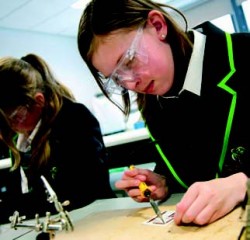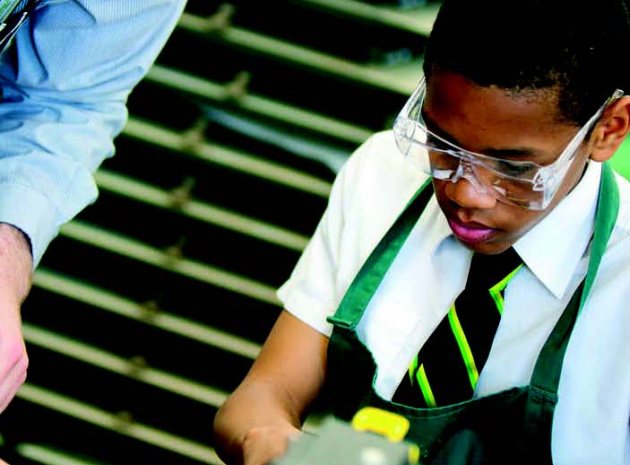The government’s proposals for reforming Key Stage 4 qualifications have prompted some passionate debate and considerable soul searching amongst teachers. It’s fair to say, in fact, that they have reignited discussion about the purpose of education itself: should it be based on a narrow measure of academic achievement or would it actually be better aimed at equipping young people with a broader set of skills that they can use in their future lives?
Design and technology can offer an important perspective. The government’s English Baccalaureate proposals place a strong emphasis on academic knowledge – but in a rapidly changing and technology-driven society and labour market, future school leavers are going to be challenged to deliver so much more than this. They will need to be innovators, to solve complex problems and to be able to present ideas and work with others to develop and implement them; and they will have to test and evaluate the solutions they come up with. In our information-rich world, knowledge is more available than ever; what is needed is the skill and judgement to apply this knowledge effectively.

Making things happen
In many ways the design and technology classroom can be seen as a crucible where concepts and principles from other subject areas combine to address real world problems. In this environment, concepts that many children find difficult to understand or care about elsewhere, suddenly come to life. D&T provides a natural focus for other subject areas including maths, science and art, and challenges pupils to integrate knowledge, understanding and skills into a working solution. The proof and value of their learning is their ability to synthesise their knowledge and use it coherently to make design solutions. It has a valuable integrating influence on young people’s learning across the curriculum, therefore – an influence that can be particularly valuable in secondary education, where fragmentation is a very real danger.
Most people would share the government’s call for rigorous academic assessment. But it is an inherent quality of an applied subject like design and technology that it carries a particular rigour of its own: Does the product actually work as intended? Does it meet the intended purpose? Would I be happy to use this in my home? This kind of evaluation is in many ways far closer to that which students are most likely to encounter in their future careers.
Through learning design as a process, young people are able to develop a wide range of skills and at the same time gain a real insight into how they might be used in future careers. Design and technology provides concrete learning experiences that enable young people to apply their knowledge in new contexts and through this, develop genuine understanding.
Moreover, the practical nature of these learning experiences makes them accessible to all students, who draw on knowledge and understanding from across the curriculum (numeracy, literacy and communication skills) and are required to apply these in practical ways. This may consolidate skills that are learned in other lessons and reinforce learning with positive outcomes. Designing and making usable products can give students a real sense of achievement. They can benefit from seeing their own progress and taking responsibility for their own learning. Their personal engagement with the task can often result in improvements to their attention span, patience, persistence and commitment.

The creative curriculum
It is a concern that, with the current exclusion of subjects like music, art, drama and dance, as well as design and technology, the government’s proposals for the curriculum of the future appear to offer little in the way of creativity. As teachers will testify, creativity comes naturally to children as part of their natural desire to learn. They have an innate desire to experiment and engage with their world in a practical and hands-on way and to work out how to overcome the challenges they encounter.
Creativity also makes a huge contribution not only to our culture but also to our economy. Britain’s creative sector – from product design and architecture to music, media and fashion – is world renowned, and one of our most distinctive and enduring areas of global competitive advantage. We need our very brightest young people to be creative and able to focus their talent on real-world challenges. Design and innovation are widely identified as drivers of economic growth and the basis of Britain’s long-term competitive advantage. Without an applied subject like design and technology, then, where will this innovation come from?
Some have raised concerns that the E-Bacc may mark a return to a more divisive school environment in which ‘academic’ and ‘non-academic’ pupils are categorised and streamed separately. More than ever, this idea of separating ‘thinkers’ and ‘doers’ seems absurd. If we peel away the ‘academic’ from the ‘practical’ subjects, surely there is a danger that the academically gifted will be directed away from ‘applied’ careers in engineering or architecture or product design, which are current growth areas of an otherwise moribund economy?
The labour market has changed radically in recent years. Technical specialists are in high demand, whether installing IT systems, building or maintaining utility networks or servicing increasingly complex consumer products. Anyone who has visited a factory in recent times knows that manufacturing does not mean ‘getting your hands dirty’. It’s an area that is rediscovering the prestige it used to enjoy and Britain is at the forefront, from luxury cars to high-end fashion. This has the potential to offer challenging and well-paid careers for many young people. But will the government’s proposals help them to access these careers?
The nature of design and technology is such that it provides opportunities for young people of all abilities to engage in activities that are challenging, relevant and motivating, yet enjoyable, and which give them a sense of satisfaction and wonder in their ability to design and make. Engagement in technological activities can be a powerful motivating force for learning at all stages. For students, this process is as much about self-learning as acquiring external skills and knowledge – finding out where their strengths lie though the process of designing, making and evaluating and then working out how they might use these strengths in their future careers.
We don’t yet know the future of the English Baccalaureate. The government is currently undertaking a consultation process that finishes on 10th December. But with subjects such as design and technology, art and design and music currently excluded it is only natural to be concerned that education might become narrower in both Key Stage 3 and Key stage 4 as a consequence. And if this happens, it is not just our children who will suffer.
About the author
John Husbands is marketing and communications manager for the design and technology association, which provides support, advice and leadership to all those involved in teaching design and technology. It also represents the interests of its members to government and raises awareness of the importance of the subject outside the education community including to business and industry. For more information visit www.data.org.uk











“In our information-rich world, knowledge is more available than ever; what is needed is the skill and judgement to apply this knowledge effectively”